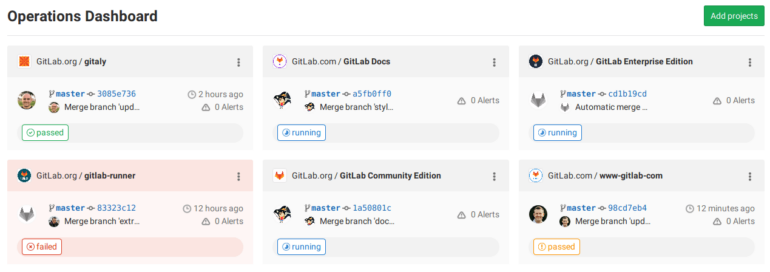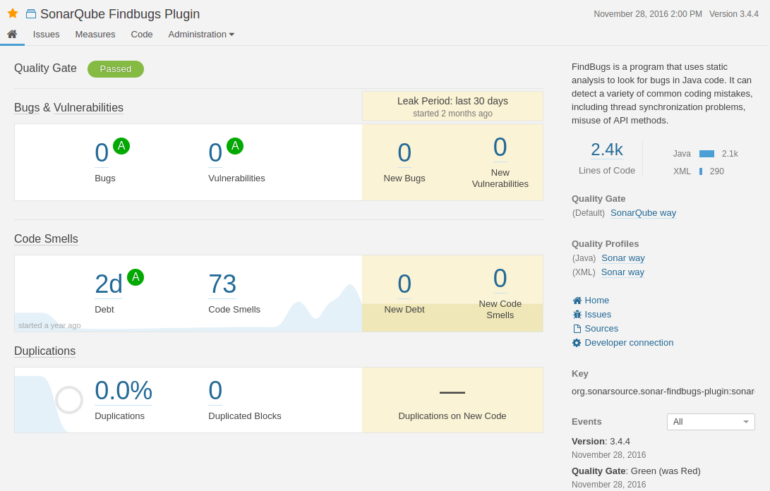Not to be confused with DevOps (development and operations), DevSecOps (development, security and operations) automatically integrates security into each stage of the software development lifecycle (SDLC), all the way from initial design to ongoing monitoring and maintenance. In doing so, it helps teams release highly secure software without slowing down the SLDC to fix costly and complex security issues as they appear later.
This guide will break down the following top DevSecOps tools for developers in terms of their features, pros, cons and pricing:
- GitLab, ideal for developers seeking a comprehensive AI-powered DevSecOps platform with CI/CD, testing, scanning and collaboration capabilities.
- OWASP ZAP, a great choice for developers looking for a user-friendly, free and open-source dynamic application security testing tool for spotting a wide variety of security issues in web applications.
- SonarQube, a solid pick for developers looking for an open-source static application security testing tool with support for multiple programming languages to improve code quality and enhance security.
Jump to:
- Gitlab
- OWASP ZAP
- SonarQube
- What to Look for in DevSecOps Software
- Final Thoughts on the Best DevSecOps Tools for Developers
GitLab

GitLab is a comprehensive DevSecOps platform powered by AI that offers continuous integration, continuous delivery, security scanning, testing, collaboration and more.
Features of GitLab
Some of GitLab’s top features as a DevSecOps tool include:
- Container and dependency scanning.
- Security test reports.
- Unit test reports.
- License compliance.
- Browser/load performance testing.
- Collaboration.
- Auto DevOps.
- Docker containers.
- Web terminals.
- Feature flags.
GitLab’s container/dependency scanning and security test reports check for vulnerabilities, while its unit test reports spot test failures on merge requests. The developer tool lets you scan project dependencies for licenses and test to see how pending code changes will impact browser or server performance. It also lets you collaborate with other developers through the Chat Ops and Review Apps features that offer Slack integration and code change previews. Auto DevOps offers pre-configured features and integrations for software delivery, and you can run CI/CD jobs in Docker containers separately. Interactive web terminals help debug running jobs, while feature flags minimize risk when sending new application features to production.
Pros of GitLab
GitLab’s strengths include:
- Enhanced security.
- Code quality feature.
- User-friendliness.
- Support for top languages/frameworks.
Top-notch security is a must when choosing a DevSecOps tool, and GitLab offers just that with container scanning, vulnerability management, advanced security testing, etc. GitLab helps developers keep code readable, concise and maintenance-free. Additionally, the developer tool is rather easy to use right out of the box. Another GitLab strength is its support for multiple languages and frameworks, giving software development teams ultimate flexibility.
Cons of GitLab
GitLab’s weaknesses include:
- Scaling complexity.
- Price for premium plans.
- Interface performance.
Development teams working with large, complex projects may find it challenging to scale with GitLab. To unlock the DevSecOps platform’s more advanced security features, you must pay a premium that can get pricey for larger teams. And the intuitive interface has a bit of a reputation for being slow to respond.
Pricing of GitLab
GitLab offers DevSecOps functionality via SaaS and self-managed options and four pricing plans:
- Free: No cost for individuals.
- Premium: $29 per user, per month.
- Ultimate: $99 per user, per month.
- Dedicated: Custom pricing with a 1,000-seat commitment.
The Free plan includes 400 monthly compute minutes, 10GB transfer per month, 5GB of storage, an open-source MIT license, free static websites and bring your own GitLab CI/CD runners.
The Premium plan includes 10,000 monthly compute minutes, 100GB transfer per month, 50GB of storage, advanced CI/CD, code reviews, enterprise Agile planning, self-managed reliability, release controls and support. The Ultimate plan includes 50,000 monthly compute minutes, 500GB transfer per month, 250 GB of storage, advanced security testing, security risk mitigation, portfolio management, value stream management, compliance and free guest users. The fully-managed GitLab Dedicated plan offers full data and source code isolation, data residency in your chosen region, regular upgrade cadence and enterprise-grade security.
Check out our GitLab CI/CD Tool Review for more.
OWASP ZAP

OWASP ZAP (Zed Attack Proxy) is a user-friendly and free open-source security scanner for web applications. The dynamic application security testing (DAST) tool is intended for developers and security professionals. ZAP offers manual and automated scanning and can detect various vulnerabilities, including sensitive data exposure, broken authentication, SQL injection, cross-site scripting (XSS) and more.
Features of OWASP ZAP
Some of the features that make OWASP ZAP popular amongst the DevSecOps community include:
- Proxying.
- Fuzzing.
- Automated scanning.
- Active and passive scanning.
- Reporting.
- Third-party integrations.
Developers can use OWASP ZAP as a proxy server, putting it between the web browser and web application so it can intercept and analyze traffic to spot vulnerabilities invisible to the end user.
They can also use ZP to fuzz web apps with unexpected input to spot vulnerabilities that sneak by other detection methods.
ZAP lets DevSecOps teams automate scanning to save time and boost efficiency, and it also offers active and passive scanning. Detailed reporting helps make sense of detected vulnerabilities so developers can fix issues faster, and ZAP is extensible via third-party integrations with CI/CD pipelines, automated testing workflows and other programmer tools.
Pros of OWASP ZAP
OWASP ZAP’s pros include:
- Open-source nature.
- Customization.
- Integrations.
- Large community.
Developers with limited budgets will love that OWASP ZAP is open-source and free to use. The highly customizable programmer tool allows developers to build custom scripts to fit their specific testing needs. ZAP is ideal for DevSecOps practices since it integrates CI/CD pipelines and automated testing workflows. And the programmer tool also has a large, active community that offers plenty of extensions, scripts, resources and support.
Cons of OWASP ZAP
OWASP ZAP’s cons include:
- Resource consumption.
- Overwhelming output.
- False positives.
- Coverage limitations.
Automated ZAP scans have the potential to consume a lot of resources and negatively impact application performance, which can be concerning in production environments. The DevSecOps tool can generate an overwhelming amount of data and output that could seem unmanageable without filters and reporting. As with other DAST tools, OWASP ZAP can generate false positives. This creates extra work for security and development teams, as they must manually verify vulnerability existence. And while ZAP can uncover a wide range of vulnerabilities, it may not spot them all. As such, you should pair ZAP’s DAST capabilities with manual penetration or static analysis testing for more comprehensive coverage.
Pricing of OWASP ZAP
OWASP ZAP is an open-source dynamic application security testing tool. As such, you can download and use it for free without paying for a subscription or license.
SEE: What is the DevSecOps security software cycle?
SonarQube

SonarQube is an open-source static application security testing tool that continuously inspects code quality and security. It integrates seamlessly into CI/CD pipelines for automation, supports multiple programming languages, detects duplicate code and security vulnerabilities and offers static code analysis.
Features of SonarQube
Some of SonarQube’s highlighted features include:
- Multi-language support.
- Static code analysis.
- Code smells.
- Quality gates.
- Reporting.
- Integrations.
SonarQube offers developers plenty of flexibility by supporting multiple programming languages. The DevSecOps tool offers static code analysis to spot coding violations and quality issues, source code security vulnerabilities and more. SonarQube also excels at spotting code smells and technical debt that make code harder to maintain.
Developers can use SonarQube to set up quality gates in their CI/CD pipelines and get comprehensive reporting on security vulnerabilities, code quality and technical debt. Extensibility comes via third-party integrations with CI/CD pipelines and other developer tools.
Pros of SonarQube
SonarQube’s advantages include:
- Open source.
- Comprehensive code quality.
- Multi-language support.
- CI/CD integration.
SonarQube’s free and open-source Community Edition is a plus for developers with limited budgets. The DevSecOps tool does a good job of detecting code smells, bugs and vulnerabilities and its support for a ton of languages is another plus. SonarQube also excels in the integrations department, particularly with CI/CD pipelines.
Cons of SonarQube
SonarQube’s disadvantages include:
- Complex configuration.
- False positives.
- Limited documentation.
Some beginners may find SonarQube complex to set up and configure. False positives create more manual work for development and security teams, and the programmer tool’s documentation could be more detailed, especially for overwhelmed beginners.
Pricing of SonarQube
SonarQube’s pricing is as follows:
- Community Edition: Free and open source.
- Developer Edition: Starts at $150 per year for a max analysis of 100,000 lines of code.
- Enterprise Edition: Starts at $20,000 per year for a max analysis of one million lines of code.
- Data Center Edition: Starts at $130,000 per year for a max analysis of 20 million lines of code.
The free and open-source Community Edition includes static code analysis for 19 programming languages, basic bug and vulnerability detection, security hotspots, CI/CD integration, code quality metrics, code smells tracking and extensibility through 50-plus community plugins. The Developer Edition adds support for more programming languages, advanced vulnerability detection, feature and maintenance branch analysis and pull request analysis.
The Enterprise Edition adds support for even more programming languages, project PDF and security reports, portfolio management, project transfer, parallel processing of analysis reports and regulatory reports. The Data Center Edition adds data resiliency, horizontal scalability and component redundancy.
What to Look for in DevSecOps Software
With various DevSecOps solutions on the market, you must know what to look for to filter your results. Online reviews can tell you if DevSecOps software is user-friendly, easily configurable and has an intuitive interface so all team members can adopt it without issue. If you plan on growing your portfolio, scalability is key. And if you want a developer tool that fits you and not the other way around, customization is also essential.
Compatibility ensures the DevSecOps tool you choose works seamlessly with your cloud platform, version control system, CI/CD pipeline, etc. while having plenty of third-party integrations ensures you can extend the tool to fit your needs. Solid DevSecOps tools should offer automation throughout the SDLC via features like continuous monitoring and automated security testing. Other features they should have include dashboards for visualization, reporting, a wide range of security testing capabilities (container security, compliance scanning, infrastructure security, SAST, DAST, etc.), compliance, extensive documentation and support, a strong user community, real-time feedback, collaboration and a price that fits your budget. Lastly, look for reviews to ensure the DevSecOps tool has solid performance and will not negatively impact your software development processes.
Final Thoughts on the Best DevSecOps Tools for Developers
DevSecOps tools integrate security throughout the DevOps lifecycle without sacrificing speed and offer collaboration, automation and other capabilities to help development teams boost efficiency and productivity.
The DevSecOps tools listed above are some of the top options on the market. Before choosing one, make sure it fits your software development team’s needs in terms of user-friendliness, scalability, extensibility, customization, pricing and features.






